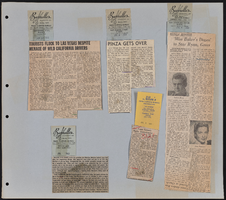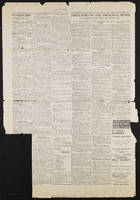Search the Special Collections and Archives Portal
Search Results
Rinker, C. A. Earle (Cleveland A. Earle), 1883-1965
Cleveland A. Earle Rinker was born in Indiana in 1883 to S. Cleveland Rinker and Isadora (Fenwick) Rinker. Shortly after his twentieth birthday Rinker went to Parker, Indiana, seeking work as a stenographer. He soon began working as a clerk for Thomas Condon, a coal and oil dealer who was also an enthusiastic investor in Nevada gold mines. Condon encouraged Rinker to seek his fortune in the gold fields and, in late October of 1906, Rinker boarded a train to make the journey to Goldfield, Nevada.
Person
Arthur G. Grant Photograph Collection
Identifier
Abstract
Arthur G. Grant Photograph Collection (approximately 1950-1965) consists of 120mm and 35mm color photographic slides taken in the mid-1950s in and around Las Vegas, Nevada. Images depict Arthur G. Grant's home life, the Fortune Club business on Fremont Street, general downtown, Helldorado Parade, and a Mount Charleston picnic. The collection also contains images of Lake Mead boat races including an appearance by Donald Campbell and his water speed world record-setting jet powered boat, Bluebird.
Archival Collection
Ronnow Family Photographs
Identifier
Abstract
The Ronnow Family Photographs contain four black-and-white photographic prints of the Ronnow family in Southern Nevada from approximately 1870 to 1950. Also included is one large oversized black-and-white photographic print of the Old Rotary Club with C. C. Ronnow present.
Archival Collection
Nevada Consolidated Copper Company Records
Identifier
Abstract
The Nevada Consolidated Copper Company Records (approximately 1907-1978) contain the business records of the company, including correspondence, freight bills, ledgers, maps, leaching data, and books relating to mining. The majority of the records post-date the company's name change to Kennecott Mining Company.
Archival Collection
Nevada-Utah Mines and Smelters Corporation Records
Identifier
Abstract
The Nevada-Utah Mines and Smelters Corporation Records (1889-1949) are comprised of the financial records of the company's activity regarding the Manhattan mine in Pioche, Lincoln County, Nevada. The collection contains bank records, accounts, and some correspondence, and is generally related to the company's financial activities. It also includes the company's financial vouchers, bills, receipts, and checks.
Archival Collection

Transcript of interview with Carol Forsythe by Sam Copeland, March 2, 1977
Date
Archival Collection
Description
Text




